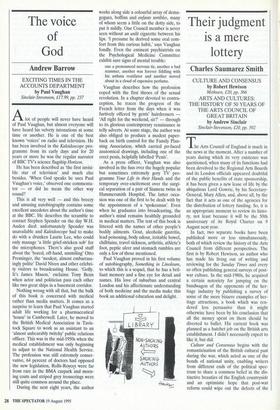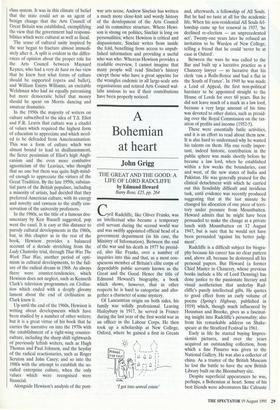Their judgment is a mere lottery
Charles Saumarez Smith
CULTURE AND CONSENSUS by Robert Hewison Methuen, £20, pp. 366 ARTS AND CULTURES: THE HISTORY OF 50 YEARS OF THE ARTS COUNCIL OF GREAT BRITAIN by Andrew Sinclair Sinclair-Stevenson, £20, pp. 502 The Arts Council of England is much in the news at the moment. After a number of years during which its very existence was questioned, when many of its functions had been devolved to the Regional Arts Boards and its London officials appeared doubtful of the public benefits of state sponsorship, it has been given a new lease of life by the ubiquitous Lord Gowrie, by his Secretary- General, Mary Allen, and, above all, by the fact that it acts as one of the agencies for the distribution of lottery funding. So, it is an appropriate moment to review its histo- ry, not least because it will be the 50th anniversary of its Royal Charter on 9 August next year.
In fact, two separate books have been published more or less simultaneously, both of which review the history of the Arts Council from different perspectives. The first is by Robert Hewison, an author who has made his living out of writing and reviewing for the Sunday Times and every so often publishing general surveys of post- war culture. In the mid-1980s, he acquired a certain notoriety for jumping on the bandwagon of the opponents of the her- itage industry by publishing a survey of some of the more bizarre examples of her- itage attractions, a book which was ren- dered less persuasive than it might otherwise have been by his conclusion that all the money spent on them should be diverted to ballet. His current book was planned as a hatchet job on the British arts establishment. I didn't necessarily expect to like it, but did.
Culture and Consensus begins with the romanticisation of the British cultural past during the war, which acted as one of the bonds of national unity, enabling writers from different ends of the political spec- trum to share a common belief in the dis- tinctive beauties of the English countryside and an optimistic hope that post-war reform could wipe out the defects of the class system. It was in this climate of belief that the state could act as an agent of benign change that the Arts Council of Great Britain was established, exemplifying the view that the government had responsi- bilities which were cultural as well as fiscal.
The sense of cultural unity inspired by the war began to fracture almost immedi- ately after it. A split is evident in the differ- ences of opinion about the proper role for the Arts Council between Maynard Keynes, who had a very de haut en bas view that he knew best what forms of culture should be supported (opera and ballet), and William Emrys Williams, an excitable Welshman who had an equally patronising but more democratic belief that money should be spent on Morris dancing and amateur dramatics.
In the 1950s the majority of writers on culture subscribed to the idea of T.S. Eliot and F.R. Leavis that culture was a citadel of values which required the highest form of education to appreciate and which need- ed to be defended from Americanisation. This was a form of culture which was almost bound to lead to disillusionment, the fierce pessimism of Eliot's high Angli- canism and the even more combative agnosticism of the Leavises, who thought that no one but them was quite high-mind- ed enough to appreciate the virtues of the Great Tradition. By the late 1950s, substan- tial parts of the British populace, including a minority of artists, had decided that they preferred American culture, with its energy and novelty and rawness to the stuffy con- servatism of the university professors.
In the 1960s, as the title of a famous doc- umentary by Ken Russell suggested, pop went the easel. It is easy at this distance to parody cultural developments in the 1960s, but, in this chapter as in the rest of the book, Hewison provides a balanced account of a decade stretching from the Lady Chatterley trial, through That Was The Week That Was, another period of opti- mism in cultural developments, to the fail- ure of the radical dream in 1968. As always there were counter-tendencies, which Hewison does not neglect, such as Kenneth Clark's television programmes on Civilisa- tion which ended with a deeply gloomy lament about the end of civilisation as Clark knew it.
Up until the end of the 1960s, Hewison is writing about developments which have been studied by a number of other writers; but it is a great virtue of his book that he carries the narrative on into the 1970s with the establishment of a right-wing counter- culture, including the sharp shift rightwards of previously leftish writers, such as Hugh Thomas and Paul Johnson, and the heyday of the radical reactionaries, such as Roger Scruton and John Casey; and so into the 1980s with the attempt to establish the so- called enterprise culture, when the only values which were recognised were financial.
Alongside Hewison's analysis of the post- war arts scene, Andrew Sinclair has written a much more close-knit and wordy history of the development of the Arts Council and its committee structure. Where Hewi- son is strong on politics, Sinclair is long on personalities; where Hewison is critical and dispassionate, Sinclair writes from inside the fold, benefiting from access to unpub- lished information and providing a useful who was who. Whereas Hewison provides a readable overview, I cannot imagine that many people will read Sinclair's history except those who have a great appetite for the wrangles endemic in all large-scale arts organisations and retired Arts Council wal- lahs anxious to see if their contributions have been properly noticed.



















































 Previous page
Previous page